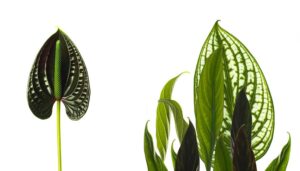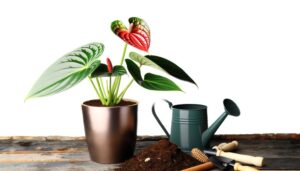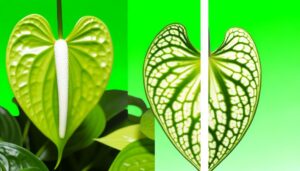Caring for Anthurium Crystallinum X Magnificum: A Guide!
Anthurium Crystallinum X Magnificum, a cherished hybrid, thrives under indirect, bright light and demands high humidity levels (70-80%) for peak health. Utilize a well-draining, aerated substrate enriched with organic matter, avoiding waterlogged conditions to prevent root rot.
Water when the top inch of soil is dry and make sure pots have drainage. Fertilize bi-weekly during growth periods with a balanced, water-soluble formula supplemented with micronutrients.
Regular pruning and sterility of tools curb pathogen spread. Repot biennially, checking roots and using slightly larger containers.
For detailed insights on pest control, propagation, and more advanced care techniques, continue to the full guide.

Key Takeaways
- Provide bright, indirect light and avoid direct sunlight to prevent leaf scorching.
- Water when the top inch of the soil is dry to maintain moisture without causing root rot.
- Maintain humidity levels between 70-80% using humidifiers or pebble trays.
- Use a well-draining, aerated soil mix rich in organic matter like orchid bark and perlite.
- Fertilize bi-weekly with a balanced, water-soluble fertilizer during the growing season.
Understanding Your Anthurium Hybrid
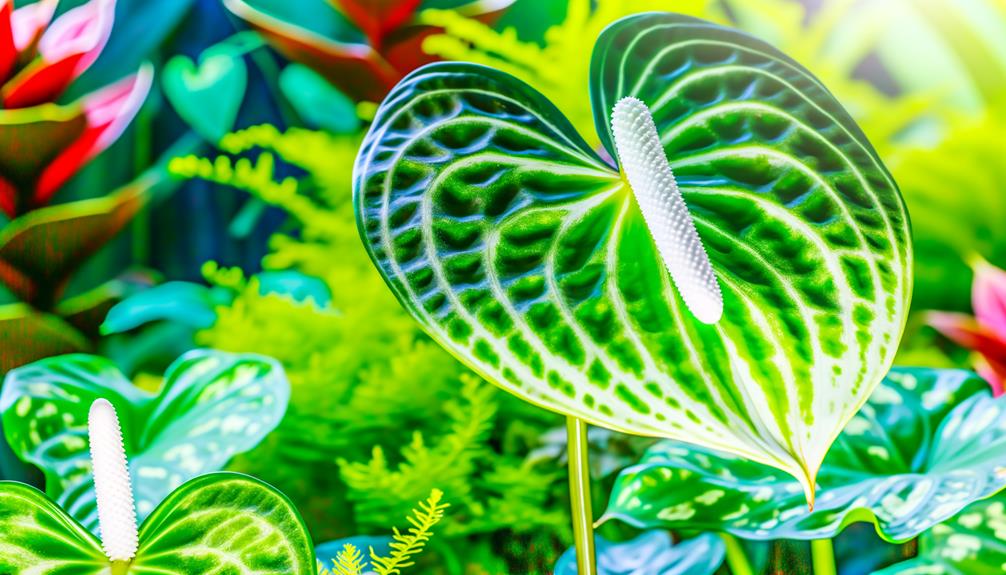
Understanding your Anthurium hybrid necessitates a thorough grasp of its genetic lineage, specifically the traits inherited from its parent species, Anthurium crystallinum and Anthurium magnificum.
Anthurium crystallinum contributes its prominent velvety, dark green leaves with striking white venation, which enhances the hybrid’s visual appeal.
Meanwhile, Anthurium magnificum imparts its larger leaf size and robust growth habit, resulting in a more vigorous plant. This hybridization produces a specimen that combines aesthetic elegance with resilience.
The foliage exhibits a heart-shaped morphology, with a pronounced velutinous texture and prominent venation patterns.
Recognizing these inherited characteristics aids in understanding the hybrid’s unique needs and potential challenges, thereby informing effective cultivation practices. This foundational knowledge is pivotal for optimizing plant health and achieving excellent growth outcomes.
Ideal Lighting Conditions
Anthurium Crystallinum X Magnificum thrives under indirect, bright light, which mirrors its native understory habitat. Best growth is achieved when exposed to filtered sunlight, avoiding direct exposure that can cause foliar damage.
For environments lacking sufficient natural light, the implementation of full-spectrum artificial lighting is recommended to simulate the plant’s ideal photoperiod and intensity.
Natural Light Levels
Ideal growth of Anthurium Crystallinum X Magnificum requires exposure to bright, indirect sunlight, ensuring the plant receives ample light without the risk of leaf scorch.
This species thrives under filtered light conditions, similar to its native understory habitat in tropical rainforests.
Direct sunlight can lead to photodamage, appearing as leaf burn or chlorosis. Best positioning includes placing near east or north-facing windows, where ambient light is diffused. Alternatively, placing the plant behind sheer curtains can effectively reduce direct sunlight exposure.
Ensuring a consistent light gradient promotes strong photosynthetic activity, essential for the plant’s vibrant foliage and overall health. Monitoring light intensity with a light meter can offer precision, maintaining ideal brightness levels between 10,000 and 20,000 lux.
Artificial Lighting Tips
In scenarios where natural light is insufficient or inconsistent, implementing artificial lighting systems can effectively replicate the ideal light conditions required for Anthurium Crystallinum X Magnificum.
High-quality LED grow lights are recommended, as they emit a spectrum closely resembling natural sunlight.
Positioning the lights approximately 12-18 inches above the plant ensures best light intensity without causing photodamage. A photoperiod of 12-14 hours per day is optimal to simulate the plant’s native tropical environment.
Additionally, maintaining a light intensity of 10,000 to 20,000 lux promotes healthy foliage and vibrant coloration.
Regularly monitoring the plant’s response to artificial lighting, such as leaf coloration and growth patterns, is essential for making necessary adjustments to enhance conditions.
Watering Requirements
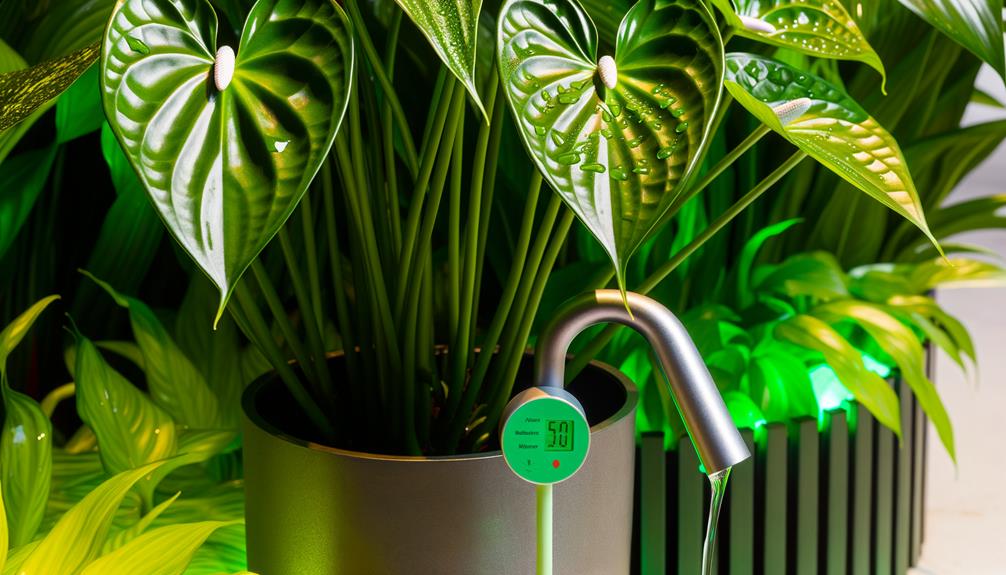
Proper hydration for Anthurium Crystallinum X Magnificum necessitates a regimented watering schedule to maintain ideal soil moisture levels. This hybrid species thrives in substrate conditions that are consistently moist but not waterlogged, necessitating careful monitoring to prevent root rot.
It is critical to allow the top inch of soil to dry out between waterings to balance hydration and aeration.
Optimal Watering Frequency
To achieve the most favorable growth for Anthurium Crystallinum X Magnificum, it is essential to maintain a balanced watering schedule that keeps the soil consistently moist but not waterlogged.
This hybrid variety thrives under conditions that mimic its natural rainforest habitat, requiring careful attention to its hydration needs.
Watering frequency should be adjusted based on environmental factors such as humidity, temperature, and light exposure.
Typically, watering once a week suffices, but adjustments are necessary during seasonal changes.
| Season | Frequency |
|---|---|
| Spring | Weekly |
| Summer | Twice a week |
| Fall | Weekly |
| Winter | Bi-weekly |
Monitoring the plant’s condition and soil moisture will provide critical feedback, ensuring the most favorable hydration without risking root rot.
Soil Moisture Levels
Maintaining ideal soil moisture levels is essential for the health of Anthurium Crystallinum X Magnificum, requiring a balance that prevents both dehydration and waterlogging. This hybrid thrives in consistently moist, well-draining substrates.
Proper moisture management encompasses several key aspects:
- Substrate Selection: Utilize a well-aerated mix containing components such as orchid bark, perlite, and sphagnum moss to facilitate excellent drainage and moisture retention.
- Watering Frequency: Water when the top inch of soil feels dry to touch, making sure that the root zone remains sufficiently moist but not saturated.
- Humidity Control: Maintain ambient humidity levels between 60-80% to support soil moisture retention.
- Drainage: Guarantee pots have adequate drainage holes to prevent water stagnation and root rot.
Humidity Levels
Optimum moisture levels for Anthurium Crystallinum X Magnificum range between 70% and 80%, vital for mimicking their natural tropical habitat.
Humidity within this range promotes peak physiological processes, such as transpiration and photosynthesis, while preventing desiccation of the foliage.
Elevated humidity levels support the integrity of the plant’s velvety, delicate leaves, reducing the likelihood of browning or curling edges.
In controlled environments, such as greenhouses or indoor setups, the use of humidifiers or pebble trays can maintain these precise conditions.
Regular monitoring with a hygrometer ensures consistency, essential for preventing stress-induced pathologies.
Conversely, insufficient humidity can lead to stunted growth and increased susceptibility to pests. Therefore, maintaining appropriate humidity is crucial for the health and vigor of Anthurium Crystallinum X Magnificum.
Soil Preferences
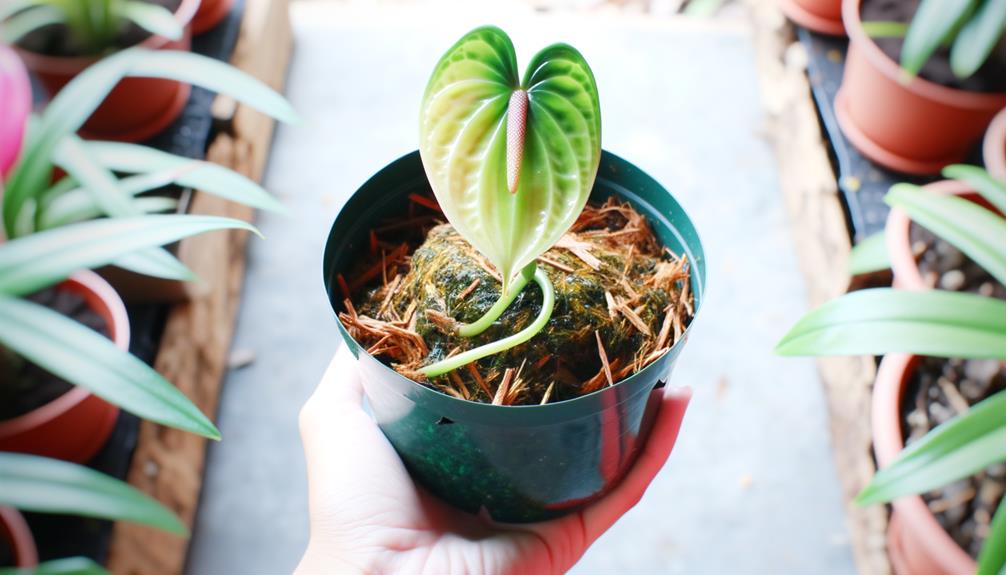
Anthurium Crystallinum X Magnificum flourishes in a well-draining, aerated substrate rich in organic matter, which closely replicates its native epiphytic conditions. Ideal soil composition is essential for promoting robust growth and preventing root rot.
The perfect mix should include the following components:
- Orchid Bark: Provides excellent drainage and aeration while mimicking the natural growing environment.
- Perlite: Improves soil structure by preventing compaction and ensuring adequate air circulation.
- Coconut Coir: Retains moisture effectively without waterlogging, supporting consistent hydration.
- Composted Leaf Litter: Supplies organic nutrients and maintains soil fertility.
This combination fosters a microenvironment conducive to healthy root development, ensuring the plant’s health and longevity. Adhering to these specifications will greatly improve the overall well-being of Anthurium Crystallinum X Magnificum.
Fertilization Tips
To support the vigorous growth of Anthurium Crystallinum X Magnificum, a balanced fertilization regimen is crucial.
Utilize a water-soluble fertilizer with an N-P-K ratio of 20-20-20, applied at half-strength. Administer bi-weekly during the active growing season, typically spring through early fall.
Micronutrients such as magnesium and calcium are equally vital; consider incorporating a balanced liquid fertilizer containing trace elements. Monitor for signs of nutrient deficiencies, like chlorosis or stunted growth, and adjust accordingly.
Avoid over-fertilization, as this can lead to root burn and hinder plant health. Regularly leach the soil to prevent salt accumulation.
Employing these precise fertilization strategies will guarantee the Anthurium Crystallinum X Magnificum thrives with robust foliage and ideal growth.
Pruning and Maintenance
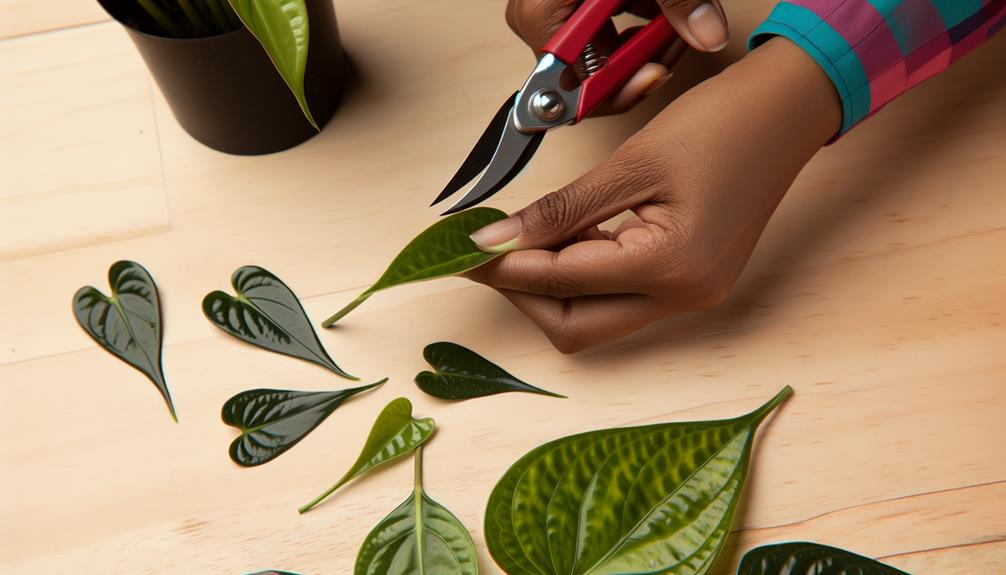
Pruning and maintenance of Anthurium Crystallinum X Magnificum are essential for promoting peak health and aesthetic appeal.
This involves the systematic removal of senescent leaves to prevent potential pathogen proliferation and to allocate resources towards vigorous growth.
Additionally, a regimented cleaning routine is necessary for maintaining foliar vitality and preventing dust accumulation, which hinders photosynthetic efficiency.
Removing Dead Leaves
Effective maintenance of Anthurium Crystallinum X Magnificum requires the regular removal of senescent foliage to promote best plant health and growth.
Pruning dead or yellowing leaves is essential for preventing disease, enhancing air circulation, and redirecting nutrients to healthier parts of the plant.
Follow these steps for best results:
- Identification: Regularly inspect the plant for leaves showing discoloration, wilting, or necrosis.
- Sanitization: Sterilize pruning shears with isopropyl alcohol to prevent pathogen transmission.
- Technique: Cut leaves at the base, close to the main stem, ensuring a clean, angled cut to minimize tissue damage.
- Disposal: Properly dispose of removed foliage to reduce the risk of pest infestation and fungal spread.
Adhering to these practices ensures vibrant, robust Anthurium Crystallinum X Magnificum growth.
Encouraging New Growth
Encouraging new growth in Anthurium Crystallinum X Magnificum requires a strategic approach to pruning and maintenance, focusing on stimulating vegetative development while maintaining plant health.
Pruning should target senescent or damaged foliage, which diverts resources from new growth. Utilize sterilized, sharp pruning shears to excise these detriments, minimizing pathogen transmission.
Additionally, removing faded inflorescences redirects energy to foliar development. Maintenance includes monitoring environmental parameters such as light, humidity, and nutrient availability.
Optimum light intensity between 1000-1500 foot-candles and maintaining humidity above 70% are crucial.
Fertilization with balanced, slow-release nutrients supports sustained growth. Regular inspection for pests and diseases, coupled with prompt intervention, ensures the plant’s vigor, fostering robust new growth.
Regular Cleaning Routines
To maintain the health and aesthetic appeal of Anthurium Crystallinum X Magnificum, it is crucial to implement a thorough cleaning routine that includes both pruning and detailed maintenance practices.
Pruning not only removes dead or diseased foliage but also stimulates new growth and prevents the plant from becoming leggy. Detailed maintenance ensures essential conditions for the plant’s sustained strength.
Key steps include:
- Sterilize Pruning Tools: Use 70% isopropyl alcohol to sanitize tools, preventing pathogen transmission.
- Remove Dead Foliage: Trim off yellow or brown leaves to redirect the plant’s energy.
- Inspect for Pests: Regularly check the underside of leaves for signs of pests like aphids or spider mites.
- Clean Leaf Surfaces: Gently wipe leaves with a damp cloth to remove dust and enhance photosynthesis.
Repotting Guidelines
Repotting an Anthurium Crystallinum X Magnificum requires careful attention to root health and substrate composition to achieve peak growth conditions. Ideal repotting intervals are typically biennial, aligning with the plant’s growth cycle.
Utilize a well-draining, aerated substrate consisting of orchid bark, perlite, and sphagnum moss to maintain adequate moisture without waterlogging.
Prior to repotting, inspect roots for signs of rot or damage, excising any compromised sections with sterilized tools. Select a container slightly larger than the current one to prevent water retention issues.
Post-repotting, place the plant in a humid, indirectly lit environment to minimize transplant shock. Monitoring for initial signs of stress, such as leaf wilting or discoloration, is crucial for successful acclimatization.
Pest and Disease Control
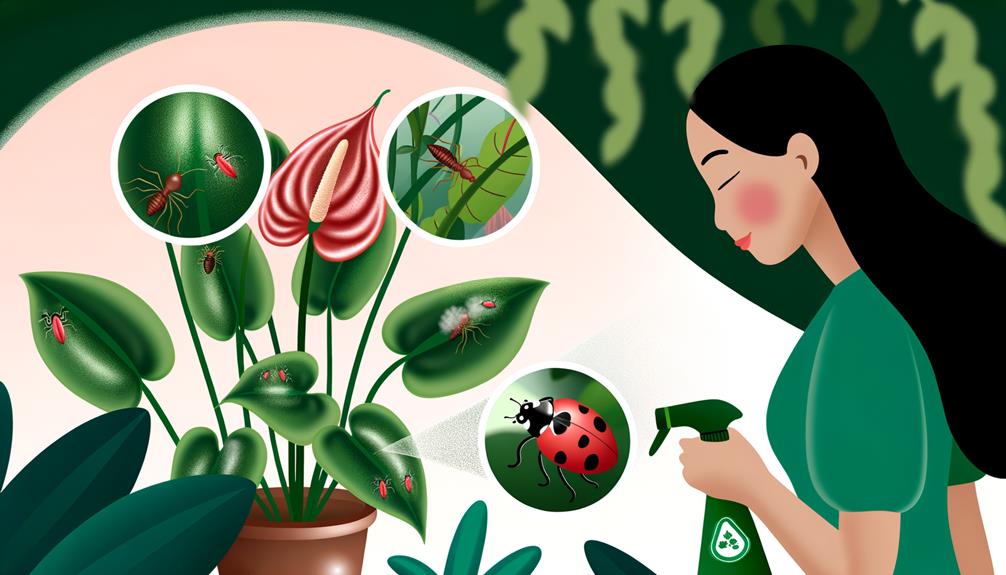
Effective pest and disease control for Anthurium Crystallinum X Magnificum involves regular monitoring for common issues such as spider mites, aphids, and fungal infections, and implementing integrated pest management strategies to maintain plant health.
Key steps in effective pest and disease management include:
- Regular Inspection: Conduct thorough checks of foliage and soil for early detection of pests and signs of disease.
- Environmental Control: Maintain ideal humidity and temperature levels to deter pest proliferation and fungal growth.
- Chemical Treatments: Apply appropriate insecticides and fungicides as needed, following manufacturer recommendations to avoid phytotoxicity.
- Biological Controls: Utilize beneficial insects like ladybugs and predatory mites to naturally reduce pest populations.
This approach minimizes risks and promotes a healthy, thriving Anthurium Crystallinum X Magnificum.
Propagation Methods
In addition to maintaining robust pest and disease control, understanding the propagation methods for Anthurium Crystallinum X Magnificum is essential for cultivating new plants and promoting genetic diversity.
Propagation primarily occurs through two methods: vegetative division and stem cuttings. Vegetative division involves separating the root clumps, ensuring each section contains healthy roots and a shoot. This method minimizes genetic variability but ensures identical phenotypic traits.
Alternatively, stem cuttings entail excising a segment of the stem with at least one node, then rooting it in a sphagnum moss medium under high humidity conditions. This method promotes adventitious root development and can be enhanced with rooting hormones.
Both methods require meticulous care to maintain optimal temperature, humidity, and sanitation conditions.
Conclusion
The delicate symbiosis of light, water, humidity, and soil forms the foundation of nurturing Anthurium crystallinum x magnificum, a botanical marvel. Watchful care in pruning, repotting, and pest control fortifies its beauty, while propagation practices fortify its perpetual lineage.
In this intricate dance of horticultural elements, one witnesses the profound elegance of nature’s design, a proof of the seamless interplay between scientific precision and the ethereal beauty of this exquisite hybrid.

